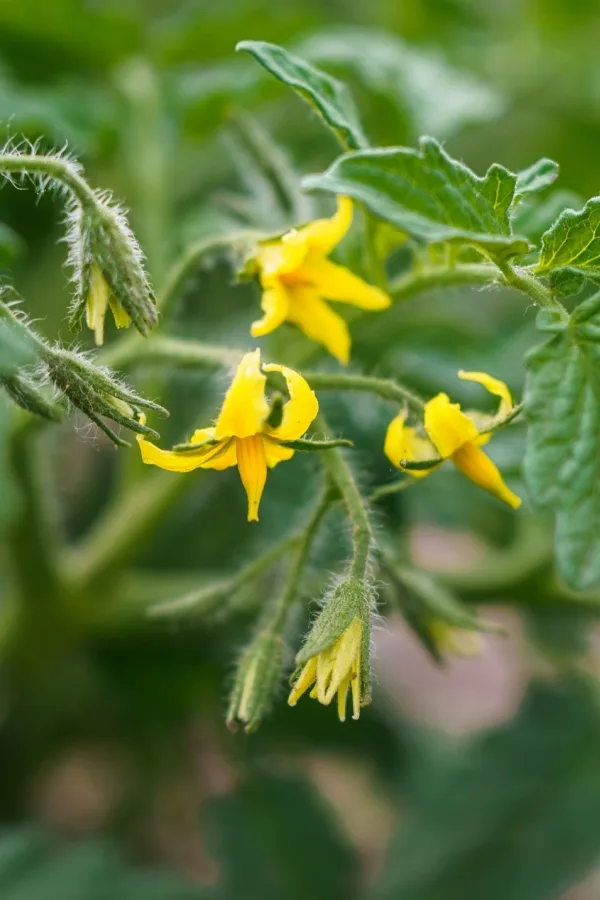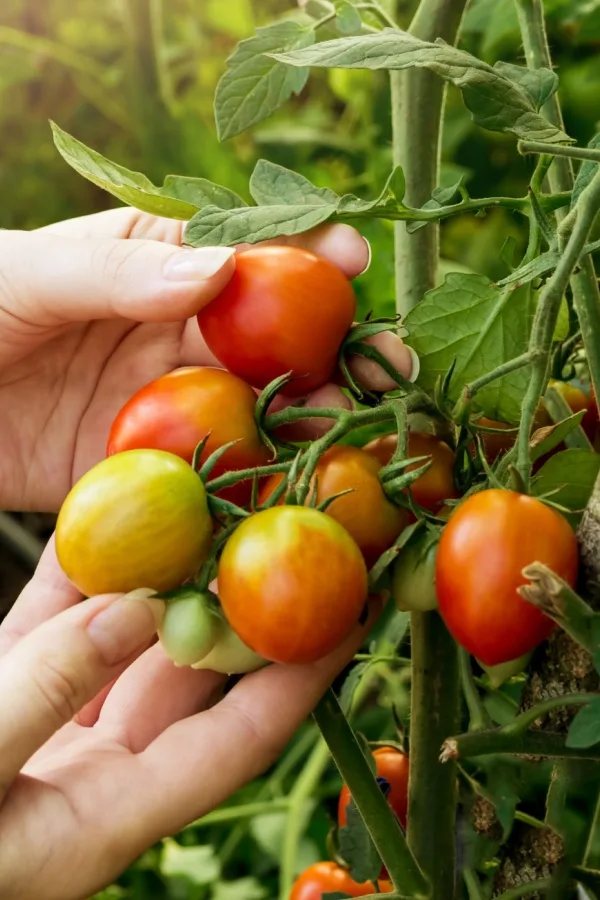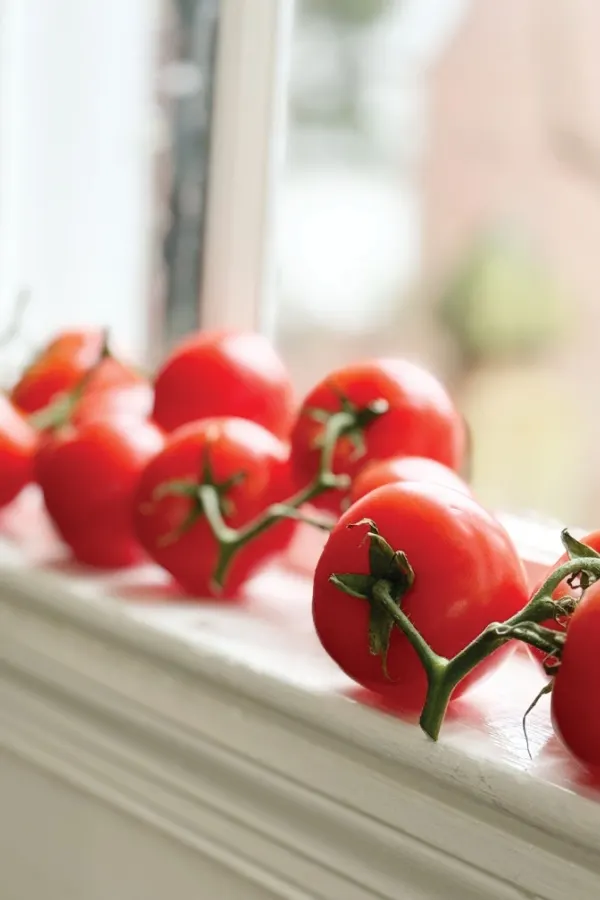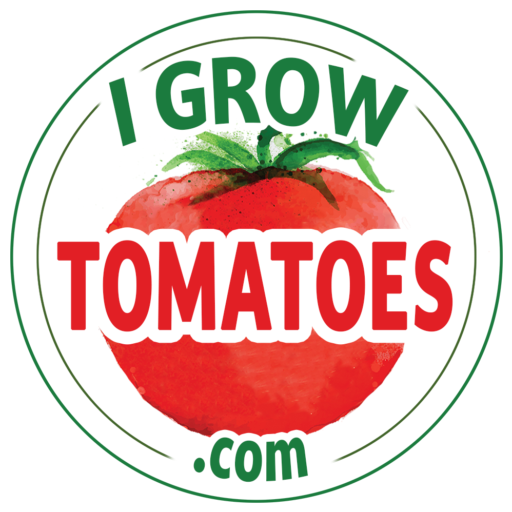One of the best and easiest ways you can help your tomato plants to stay incredibly productive during the summer months is to prevent fruit overload.
Fruit overload occurs when you have too much fruit ripening on a tomato plant at one time. While having too many tomatoes on a single plant might seem like a good thing – it can actually cause all kinds of issues. Not just for your plants – but for the tomatoes growing on them as well. Even more – as you will see in today’s article, it can severely impact your plant’s ability to produce future tomatoes as well.
With getting the most from your tomato plants in mind – here is a look at the damage fruit overload can cause – and how to pick your tomato plants to keep them healthy and productive all summer long.

How To Prevent Fruit Overload On Indeterminate Tomato Plants – And Why It’s Important!
The Issues With Fruit Overload
As soon as tomatoes start to blush (i.e., turning their mature color), the ripening process begins for a tomato. But once this happens, the fruit no longer absorbs or needs any nutrients from the plant. Unfortunately – the plant doesn’t realize this!
Even though a ripening tomato can no longer take in energy from the plant, it still constantly tries to spend energy and resources on it. And as long as that tomato continues to stay attached, the plant keeps wasting energy on it.
Obviously, if there are a lot of tomatoes ripening at once, there is a tremendous amount of wasted energy going to them. Because of that, the plant starts to have little left to spend on setting new blooms. And when there are no new blooms, there will be no more new tomatoes forming!

Another issue with having too many tomatoes on a plant at one time is the overall weight. Tomatoes can be heavy. Especially large slicing varieties. All that extra weight can easily cause branches and stems to become broken or damaged during high winds or strong storms. That, of course, can severely impact your harvest as well.
The solution? Pick your tomatoes early – and often!
When To Pick Tomatoes – How To Prevent Fruit Overload
The key to preventing fruit overload is to pick tomatoes far before they completely ripen. That may seem in contradiction with the common thought of the joy of picking a ripe, juicy red tomato right from the vine – but it truly is the better way to harvest. And for a long list of reasons!
Advantages Of Harvesting Early – How To Prevent Fruit Overload
Besides avoiding fruit overload, there are many advantages to harvesting your tomatoes early and allowing them to ripen off the vine.
First, the longer a tomato is allowed to stay on the vine, the higher the chances are that it ends up blemished or damaged. Ripening tomatoes are also more likely to split and crack due to age and inconsistent summer rains and extreme heat.

Not only that, but hungry insects and pests are also after the ripening fruit too. Just like fully ripe tomatoes are perfect for humans to consume, they are more tempting than ever to garden pests. And the longer they ripen, the more animals and insects are attracted to them.
So when should you pick? Remember that as soon as the tomato starts to blush, it no longer needs to be on the vine in order to finish the ripening process. Because of that, once they are about a third of the way changed, they are perfect for the picking!
Ripening Off The Vine – How To Prevent Fruit Overload
After you harvest the fruit, it’s time to put it in the perfect location to finish ripening off the vine. Contrary to popular belief, it’s not best to put the fruit on a sunny windowsill. For starters, once a tomato blushes, it no longer needs the sun to ripen. And that windowsill can cause big issues.

The sun’s hot rays coming through the glass can end up blistering the delicate skins and cause uneven ripening. Meanwhile, the bottom of the windowsill allows for no air circulation underneath, often causing them to rot out.
You also don’t want to put ripening fruit in the refrigerator. This will actually halt the ripening process completely. Over time, the tomato will start to lose flavor and the texture of the fruit will be negatively affected as well in the chilled environment.
Instead, it’s best to ripen fruit on a surface that allows air under and above. Baking or cooling racks are great for this – or you can even make a homemade harvest rack from hardware cloth placed on a few 2×4’s. The key is to have good air flow. Product Link: Baking / Cooling Rack
It’s also important to ripen it in a cooler area (70°F) that is out of direct sunlight. Back porches or cool rooms inside the house are perfect for this. You can also ripen in a shady area outside, but be sure to protect from hungry animals!
Indeterminate Vs Determinate Plants – Preventing Fruit Overload
So does the type of tomato you grow matter when it comes to fruit overload? As it turns out, fruit overload is most important for indeterminate tomato varieties. These types of plants are capable of setting fruit all throughout the growing season and up until the first frost.
Examples of these varieties are San Marzano, Brandywine, and many other large heirloom slicing varieties. Because these tomato varieties continue to grow, fruit overload will affect them the most.
Determinate tomatoes are plants that set fruit all within a couple of weeks. Once that time frame is up, they no longer will set new blooms. Examples of these types of tomatoes are Roma and most dwarf tomato varieties.
Because all of the fruit on determinates ripen around the same time, it will not affect more bloom production. However, the plants can still benefit from being harvested early and allowing the tomatoes to ripen off the vine as it helps the tomato plant finish strong with its final fruit.. See our article: Determinate Vs Indeterminate Tomatoes – How To Know What To Grow!
Here is to picking early and often, and getting the most from your tomato plants this year!
I Grow Tomatoes
Follow Our Facebook Page For Even More Great Tomato Growing Tips! I Grow Tomatoes Facebook Page
I Grow Tomatoes is a website created for those who love all things about tomatoes – from planting and growing – to cooking and canning! We publish two articles every week, 52 weeks a year. Sign up today to follow via email! This article may contain affiliate links.
